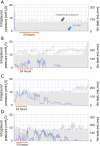Air leak pattern shown by digital chest drainage system predict prolonged air leakage after pulmonary resection for patients with lung cancer
- PMID: 30069369
- PMCID: PMC6051872
- DOI: 10.21037/jtd.2018.05.150
Air leak pattern shown by digital chest drainage system predict prolonged air leakage after pulmonary resection for patients with lung cancer
Abstract
Background: A common cause of complications after a pulmonary resection procedure is prolonged air leakage. Recently introduced digital drainage systems provide accurate recording of air leak data for later review. We investigated the clinical usefulness of the continuous stream of data recorded by such a device.
Methods: We analyzed data obtained from 299 patients with pulmonary malignancy who underwent a pulmonary resection procedure for lung cancer patients with use of a digital chest drainage system. Postoperative air leak patterns were divided into 4 groups and their correlation with prolonged air leakage after pulmonary resection was evaluated.
Results: The incidence of prolonged air leak was 10% (30/299). The postoperative air leak patterns noted in the present patients were divided into none (n=217, 73%), intermittent (n=21, 7%), decrease (n=40, 13%), and variable (n=21, 7%). The incidence of prolonged air leak in each group was 0.5% (1/217) in the none group, 24% (5/21) in the intermittent group, 20% (8/40) in the decrease group, and 76% (16/21) in the variable group. The amount of air leakage immediately after surgery was highest in the variable group. Patients in the intermittent and variable groups had longer durations of air leakage and chest tube placement. The frequency of postoperative interventional treatment was significantly higher in the variable group as compared to the others. Chest tube reinsertion for pneumothorax and increased subcutaneous emphysema after the initial chest tube removal was only seen in the intermittent group.
Conclusions: Advantages of digital drainage system use are continuous monitoring and recording capabilities, which show the detailed air leak pattern after pulmonary resection. That pattern can be used to predict the durations of air leakage and chest tube drainage, as well as for producing an air leak management algorithm.
Keywords: Air leak; digital chest drainage system; postoperative management.
Conflict of interest statement
Conflicts of Interest: The authors have no conflicts of interest to declare.
Figures



References
LinkOut - more resources
Full Text Sources
Other Literature Sources
